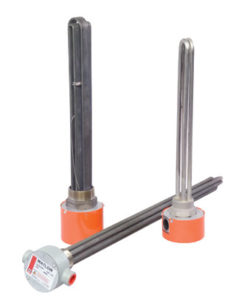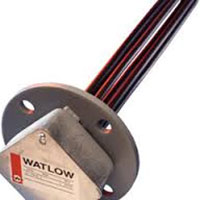Types of Immersion Heaters for Water

The three basic types of immersion heaters for water are screw plug, over the side and flanged. Understanding the differences and benefits of each heater can help you identify the optimal option for your specific process.
Screw Plug
Tubular elements are bent and then welded or brazed into a screw plug to create these convenient immersion heaters. If the liquid or gas that you’re heating needs to be in a sealed container, or if you want a more streamlined system than an over-the-side alternative, consider screw plug immersion heaters. Common thread sizes range from 1/2 inch to 2 1/2 inches.
Just like other immersion heaters for water, oil and gas heating, screw plug heaters come in a range of voltage options and sheathing materials. Take advantage of an existing threaded opening or create your own to seal an immersion heater into your process tank.
Over the Side
Connecting a heating element through a threaded access point poses a few risks, including potential leaks and difficulties repairing your heater. An over the side heater alternative is designed to wrap conveniently over the side of a traditional drum, holding tank or other system.

Choose one of these heaters if you plan on altering the container used to heat your product. It’s also a great option if you are hesitant to create a hole in your holding tank. Some over-the-side heaters connect to the lip of the tank or barrel, while others rely on gravity and a bent design.
Flanged
Similar to a screw plug heater, flanged immersion heaters for water are secured into the side of the container for the heating application. Instead of a threaded opening, these heaters require a flange and bolt for connection. Use one to safely submerge your heater in a product without worrying about dropping or damaging an over-the-side alternative.
Typical Heating Time
The time it takes to heat a liquid or gas is extremely variable. This is a critical factor that you need to consider as you shop for immersion heaters for water, but the answer depends on these variables:
- Type of immersion heater
- Sheathing material used
- Liquid or gas being heated
- Desired temperature
- Available voltage
- External operating conditions
A flanged heater has a baffled design that reduces typical heating time, so this is a popular option for rapid, high-heat applications. The available voltage limits the power capabilities of your electric heating element. If you’re attempting to heat a liquid in an outdoor space, the heating time will vary depending on the outdoor temperature.
Applications for Immersion Heaters
There are a number of applications for immersion heaters. Depending on your industrial application, an immersion heater may be perfect for you or you may need to browse our other lines of industrial heaters. Here are the most common uses for an immersion heater in an industrial setting.
Heating Liquids
Quickly heating a liquid for an industrial process is the most straightforward way to use an immersion heater. Whether you’re heating the product to create a chemical reaction or preparing to submerge a workpiece in a bath of oil, water or other liquid, immersion heaters are the ideal heating option.
These compact heaters can be discreetly installed near the bottom of a holding tank while still creating a uniform and consistent temperature throughout.
Pressurized Applications
Flanged and screw plug immersion heaters are also popular in pressurized applications. Immersion heaters for water boilers quickly heat the water to a boiling point while still maintaining a pressurized environment. Both types of heaters can be removed for maintenance reasons, but otherwise create a firm seal that creates an efficient boiler system.
Chemical Processing
Immersion heaters for water can also be used in chemical applications. Heat up a caustic cleaner, glycol solution, high-purity water, liquid paraffin or chemical bath for your specialized application.
These solutions don’t require a pressurized environment, so you can use any of the three most common types of immersion heaters. Be sure to choose a sheathing material that can withstand the corrosion or other unique properties of your solution.
Hazardous Situations
Many heating options are prone to corrosion and breakdown when used in hazardous situations. When you choose the right immersion heater from Hi-Watt, you can enjoy a durable alternative suited for your situation. Choose a corrosion-resistant material, explosion-resistant environment and a heater with the ideal sizing for your process.
How To Choose An Immersion Heater
There are a number of immersion heaters for water available, so how can you determine the exact heater needed for your process? Here is what to consider when choosing one of these industrial heaters:
- Temperature requirement
- Budget
- Sheath and flange materials
- Power density
- Safety concerns
An immersion heater can use copper, steel, Incoloy or stainless steel to protect the electrical components from the liquid. Some applications require high levels of sanitation, while others need to resist highly corrosive factors in the heating process.
Consider the temperature levels you need to reach, the material you’re heating and the budget of your heating process as you explore our immersion heater product list.
